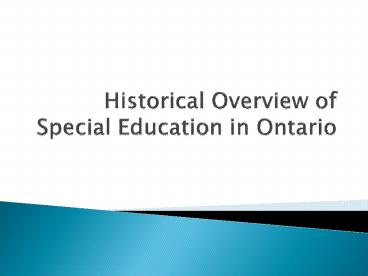Historical Overview of Special Education in Ontario - PowerPoint PPT Presentation
1 / 17
Title:
Historical Overview of Special Education in Ontario
Description:
Involvement of parents/guardians in assessment, identification, and placement decisions ... they need in order to participate in the life of Ontario communities. ... – PowerPoint PPT presentation
Number of Views:575
Avg rating:3.0/5.0
Title: Historical Overview of Special Education in Ontario
1
Historical Overview of Special Education in
Ontario
2
1950s
- Royal Commission on Education in Ontario, 1950
(AKA the Hope Report) - First look at special education
- Recommended
- Compulsory school attendance (6-16)
- Universal Kindergarten programs
- Abolition of Grade 13
- A significant expansion of special education
programs to serve children with learning
disabilities
3
1960s (Decade of ed. Reform)
- Robarts Plan reorganized schools program of
studies three academic streams (2 yr. for jobs,
4 yr. vocational training, and a more traditional
5yr. Program. - 1968 Hall-Dennis report the right of every
individual to have equal access to the learning
experience best suited to his needs, and the
responsibility of every school authority to
provide a child centred learning continuum that
invites learning by individual discovery and
inquiry.
4
1970s Further reforms
- New programs, credits, and diploma requirements
were introduced, accompanied by new teaching
techniques. - Programs and services for students with special
needs were still lacking. - School boards were not required to offer special
education programs and services.
5
1980s Focus on Special Education
- Dec. 12, 1980 An act to Amend the Education
Act, referred to as Bill 82 came into effect in
Ontario - Part of a world-wide movement to providing all
children with the opportunity for a publicly
funded education. - School boards were required to provide special
education programs and services to exceptional
students or to purchase these services through an
agreement with another publicly funded school
board.
6
1980s (cont.)
- Up to Bill 82 variation throughout Ontario
- Other aspects of Bill 82
- Early and ongoing identification and assessment
of learning disabilities and needs of students - Establishment of Identification, Placement, and
Review Committee (IPRC) - Involvement of parents/guardians in assessment,
identification, and placement decisions - Involvement of parent associations
- Rights of parents to appeal decisions (ID,
placement, IPRC
7
1980s (cont.)
- Following Bill 82 schools were given 5 years to
establish their special education plans, in
consultation with their SEACs. - Now Regulation 306 school board prepares and
approves a report on their special education
services/programs every 2 years. - Bill 82 had a significant impact on parents,
teachers, and other professionals associated with
providing special education services. Parents
and advocates became better informed.
8
1990s
- 1991 Minister of Education said
- The integration of exceptional pupils into
local community classrooms should be the norm in
Ontario, wherever possible, when such a placement
meets the pupils needs, and when it is according
to parental choice.
9
1990s (cont.)
- 1994 Asst Deputy Minister
- (commitment to integration)
- The Ministry of Education and Training remains
committed to the principle that the integration
of exceptional pupils should be the normal
practice in Ontario, when such a placement meets
the pupils needs and is in accordance with
parental wishes. A range if options including
placement in a special class or provincial or
demonstration school will continue to be
available for pupils whose needs cannot be met
within the regular classroom.
10
1990s (cont.)
- 1995s Report of the Royal Commission on Learning,
For the Love of Learning - Integration of students with special needs into
regular classrooms, with classroom support when
necessary, while acknowledging the
appropriateness of other placements, including
acceleration of gifted students.
11
2000s
- 2001 Ministrys Special Education A Guide for
Educators - Reflects changes since 1984
- Explains pertinent legislation and policy,
funding for special education, program planning,
programs and services, and the roles of and
resources provided by other ministries.
12
2000s (cont.)
- In Ontario, children who have behavoural,
communication, intellectual, physical, or
multiple disabilities or disorders, or who
gifted, may require special education services or
special education programs to enable them to
attend school and to benefit fully from their
school experience. - Such students may be formally identified as
exceptional
13
2000s (cont.)
- Subsection 8(3) of the Education Act requires the
Minister of Ed. To prescribe categories of
exceptionalities, to define exceptionalities, and
to require school boards to use the definitions.
Categories and definitions can be found in
Special Education A Guide for Educators.
14
2000s
- All students formally identified as exceptional
by an Identification, Placement, and review
Committee (IPRC) must have access to an education
that will enable them to develop the knowledge
and skills they need in order to participate in
the life of Ontario communities.
15
2000s (cont.)
- School boards are required to provide exceptional
pupils with special education programs and
special education services that are appropriate
for their needs. - Specific procedures for identification and
placement is set out in Regulation 181/98 - Also, provides for the regular review of the
identification and placement of a student and for
the appeal of decisions by parents.
16
2000s (cont.)
- When IPRC identifies a student as exceptional,
the principal must ensure that an Individual
Education Plan (IEP) is developed and maintained
for that pupil in accordance with the ministry
document Individual Education Plans Standards
for Development, Program Planning, and
Implementation, 2000 - (cont.)
17
2000s (IEP cont.)
- Input from parents must be included in the
development of the IEP - Students 16 and must be consulted
- IEP identifies students particular learning
expectation and outlines how the school will
address these expectation through appropriate
special education programs and services. - It also identifies how progress will be reviewed
- IEP will be modified on the basis of continuous
evaluation and assessment































